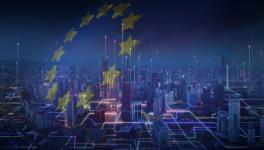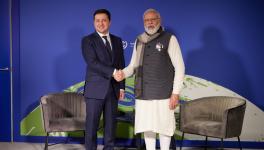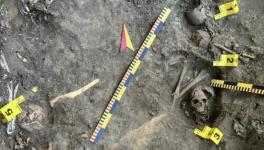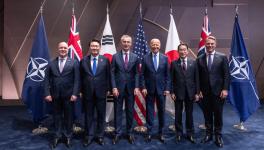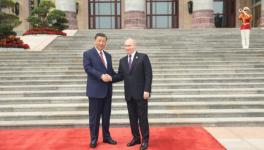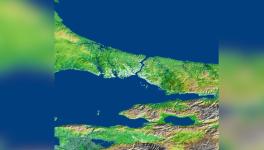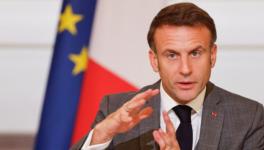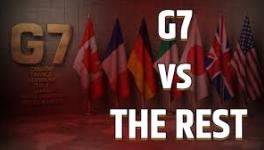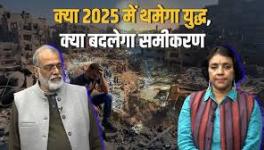Game of Nuclear Chicken in Zaporozhye
Representational use only.Image Courtesy: Wikimedia Commons
The Zaporozhye (also spelt Zaporizhzhia) Nuclear Power Plant has become a focal point in the Ukraine war, as any major nuclear incident risks radioactivity release over a vast area. In such an accident, not only Ukraine but large parts of Europe could face radioactive contamination and much higher cancer rates and other diseases. Russia has claimed the Ukrainian side shelled the Zaporozhye plant in July and August and, on 23 August, submitted photographic and other documentary evidence to the UN Security Council. Ukraine contends Russia has been shelling the plant even though it is under Russia’s occupation. [Update: the International Atomic Energy Association (IAEA) has decided to send a team of inspectors to the Zaporozhye plant, which will reach in 'next few days'.]
The Zaporozhye plant in the town of Enerhodar is the largest nuclear power plant in Europe, with six 1,000 MW capacity units. They are Pressurised Water Reactors of Soviet vintage: the oldest unit was commissioned 37 years and the newest 26 years ago. Before the war, they used to supply 20% of Ukraine’s electricity. And even after Russia captured Zaporozhye in March, they have continued supplying to the Ukrainian grid.
Before we look at the risks of a major nuclear incident on the scale of Chernobyl or Fukushima, let us take a quick look at the Ukrainian claims regarding the Russian shelling of the plant and the positioning of heavy artillery and other equipment within. It defies logic why the Russians themselves would shell a plant which, by all accounts, is under their control. All the evidence so far supports Russia’s claim that Ukraine shelled the plant and the transmission lines. And if, as Ukraine claims, Russia has positioned heavy military equipment within the plant, it should be a simple matter for Ukraine or its NATO allies to make the evidence public in the age of satellite imagery. That they have not speaks volumes.
Understandably, the Ukrainian side would make such propaganda claims. What is surprising is major news organisations—Reuters, AP, The New York Times, and The Washington Post—have all echoed Kiev’s line that Russia shelled a plant under its control or used it as a shield without even a simple fact or plausibility check. In all such reports, Kiev’s statements are faithfully carried as gospel truth. Big western media appears to be part of the Orwellian Ministry of Truth in the information war over Ukraine.
So what are the risks of a major nuclear incident in the Zaporozhye NPP? The six reactor buildings have robust containment domes and are well protected against artillery shelling and even rocket strikes. It would require bunker busters or equivalent explosives to breach reactor containment. Any accident would lead to a shutdown. However, the risk in a running nuclear plant is that it requires continuous cooling even if it has been shut down. Cooling pumps require auxiliary power. If the reactors are shut down, that auxiliary power normally comes from the grid. In an emergency, diesel generating (DG) sets can provide such auxiliary power, but only as a temporary stopgap measure.
Without cooling pumps, residual radioactivity in the nuclear core will cause continuous heating and rising temperature. If cooling cannot be restored, the core temperature will rise enough to cause a core meltdown and large-scale release of radioactivity. A core meltdown is classified as a Level 7 accident, the highest on the International Nuclear and Radiological Event Scale. Only Chernobyl and Fukushima have been classified as Level 7 incidents. The Three Mile Island nuclear plant was only 30 minutes away from a Level 7 full core meltdown.
Why is cooling the reactor core in a nuclear plant so important? The core is where heat-releasing controlled atomic fission takes place. This heat creates the steam that drives turbo-generators to produce electricity. The fission—breaking up—of uranium fuel to other highly radioactive materials continues to produce heat even after a reactor is shut down. As some of these materials have short half-lives, a shut reactor slowly cools, but cooling systems must keep running. This process makes auxiliary power for the cooling pumps necessary.
During the earthquake-tsunami that hit Japan, the Fukushima Daiichi plant lost all auxiliary power due to a grid failure. Three reactors overheated, leading to a core meltdown. The consequence was not only the release of radioactivity into the atmosphere but a huge amount of radioactive water, which is known to have discharged into the Pacific Ocean with unknown consequences for marine life. Since marine products enter our food chain, the implications of the Fukushima disaster will continue for a long time.
Though Chernobyl had a much more significant immediate impact, it was a man-made disaster. The reactor was being tested under extreme low power conditions bypassing all protections. It was the hubris of the engineers running the plant, which is unlikely to be repeated. In the Three Mile Island accident, the auxiliary cooling water pumps were manually switched off as the operating staff completely misunderstood the conditions within the reactor core. A new shift of workers diagnosed the actual event, averting what would have been another Level 7 incident narrowly.
Since auxiliary equipment is not within the reactor containment structures, it is vulnerable to shelling and bombing of the facilities. One shelling incident in Zaporozhye damaged the auxiliary equipment, though not the ones that would affect the reactor cooling systems. If the auxiliary power system fails, reactors lose their cooling system, leading to a core meltdown. DG sets can provide backup power for some time but not indefinitely support cooling systems.
The other risk to the plant comes from the cooling water ponds, which store spent fuel rods immersed in water. The spent rods have residual radioactivity and need to be stored in cooling water for an extended period for radioactive decay to occur and carry away the heat. Any shelling that hits the cooling ponds can lead to a significant release of radioactivity.
Why would Ukraine risk such an event, as it would also become a country badly affected by a Fukushima or a Chernobyl level accident? It appears the trigger for this course of action was the possibility that Russia would connect the Zaporozhye plant to the Russian grid and disconnect from the Ukraine one. The shelling of Zaporozhye started at almost the same time as such a possibility was discussed. Escalating the risk to the plant, leading to an international outcry and now an IAEA inspection, is one way to maintain the status quo and, therefore, the supply of electricity from the plant to Ukraine.
Here is the irony of the Ukraine war. While Ukraine and its NATO allies have imposed numerous sanctions on Russia, Ukraine was getting natural gas supplies from Russia and electricity from the Zaporozhye plant. With Ukraine’s industrial consumption plummeting alongside the loss of 20% of its territory, its electricity consumption has also been reduced. Consequently, it sold about 100 MW of electricity to the European Union (EU). With the price of electricity recently shooting up in the EU, if Russia disconnects Zaporozhye from the Ukraine grid, Ukraine will lose both; electricity and money. Therefore we have the Zelensky regime playing the game of nuclear chicken—who will back off first from a possible disaster—with the Zaporozhye plant.
The problem for Russia is that internationalising the shelling of the Zaporozhye plant risks the IAEA and the UN playing a role in the plant. UN Secretary-General António Guterres appears more the voice of the West than the head of the UN. Similarly, the IAEA is heavily influenced by the West, as we saw earlier during the Iraq war and its role in Iran. Though Russia has been asking for an IAEA inspection of the Zaporozhye plant for quite some time, IAEA has argued that the inspection has to take place only through Kiev-controlled territory, and the plant and its surrounding area should be demilitarized. If the task of the IAEA is nuclear safety, that should be its priority over what are clearly political demands emanating from Kiev and its NATO allies.
While the politics being played in the UN Security Council and IAEA can be understood in terms of the narrow interests of the players, should not the demand for the safety of a nuclear plant override such considerations? Should not EU countries, who would also be hit by a Chernobyl or a Fukushima level disaster, think about the interest of their people as well? Or is weakening Russia more important than the safety of its people?
The problem in the world today is that every country seems to see foreign policy in terms of its narrow self-interest. We lack the moral compass that the Non-Aligned Movement with leaders like Nehru, Nasser, Nkrumah and Sukarno brought to the world. That is what we badly miss today: a voice of reason to speak up for humanity.
Get the latest reports & analysis with people's perspective on Protests, movements & deep analytical videos, discussions of the current affairs in your Telegram app. Subscribe to NewsClick's Telegram channel & get Real-Time updates on stories, as they get published on our website.










